Note: If an image ever fails to appear - refresh your page, it really is there
Flags of the Spanish-American War Era
(Including The Kingdom of Hawaii and The Indian Wars)
| Flags of Hawaii |Flags of Spain | Flags of Cuba | Flags of the Philippines | Flags of Puerto Rico | Flags of United States |
The Flags of the Kingdom of Hawaii 1810-1898
In 1778, British Captain James Cook and his crew, while attempting to discover a "Northwest Passage" between Alaska and Asia, found the Hawaiian islands, which they named the "Sandwich Islands." After the discovery by Cook, other Europeans and Americans began comming and settling in the Sandwich Islands. (For you surfers, the first written account of surfing can be found in Captain Cook's log)
Hawaii was united under a single ruler, Kamehameha I, for the first time in 1810. Kamehameha, managed to acquire a small schooner with a cannon. With the help of his cannon and various small arms brought to the islands by settlers, he was able to take control of the island chain from Hawaii to Kauai. He instituted systems of government, commerce, and taxation, establishing his court on the main island of Hawaii and appointed governors to control all of the other islands. He is remembered as "Kamehameha the Great."
The eight rulers of the Kingdom of Hawaii were: Kamehameha the Great (King Kamehameha I 1810-1819), Liholiho (King Kamehameha II 1819-1824), Kauikeaouli (King Kamehameha III 1825-1854), Alexander Liholiho (King Kamehameha IV 1855-1863), Lot Kapuaiwa (King Kamehameha V 1863-1872), William Charles Lunalilo (King Lunalilo 1873-1874), David Kalakaua (King Kalakaua 1874-1891), and Lydia Liliuokalani (Queen Liliuokalani 1891-1893). Queen Liliuokalani, Hawaii´s last monarch, was deposed in 1893 and abdicated in 1895.
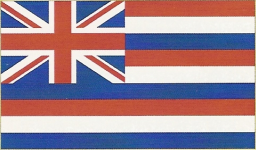
Hawaiian Flag 1816
|
Kingdom of Hawaii Flag 1816-1845
Until 1816, the chiefs of the various islands had considered themselves under British protection and flew the Union Flag. By 1816, the need for a distinctive Hawaiian flag became apparent when Hawaiian ships began trading island sanda wood in Canton(now Guangzhou), China.
Thus the monarchy establish by Kamehameha the Great adopted a new flag similar to the one used today by the State of Hawaii, with the Union Flag in the canton, but with nine horizontal stripes alternating red, white and blue from the top. This flag was designed by either Captain George Beckley, an Englishman who settled in Hawaii 1804, or by Captain Alexander Adams, also an Englishman, both of whom were in the employ of King Kamehameha I. Both accounts of the origin of the flag point to the inspiration of the design being a melding of British and U.S. flags, the most common foreign ensigns seen in Hawaiian waters in the late 18th and early 19th centuries. Both claims are also based on statements made by their descendants over a century after the fact. Neither claim can be proved by contemporary written records. Captain Adams’ journals survive in the archives of the Hawaiian Historical Society, but the crucial pages for 1816 which would either confirm or deny his descendants’ claim were torn out at an unknown date in the past, prior to their deposit with the historical society.
Dissidents among the native Hawaiian ruling families, along with infighting between Catholic and Protestant factions, gradually weakened the Royal family's control of Kamehameha's kingdom. More ranchers and missionaries (mainly from England, France, and the United States), began settling on the islands during this period of time, each with their own agendas. |
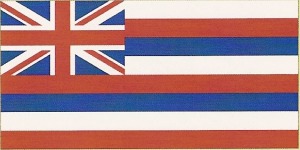
Hawaiian Flag 1845
|
Kingdom of Hawaii Flag 1845-1898
A serious incident, sometimes called the Paulet Affair, took place in 1843 when British Lord George Paulet of the HMS Carysfort entered Honolulu Harbor and captured it because of reported insults and malpractices against British subjects. Paulet demanded that King Kamehameha III abdicate and that the Hawaiian Islands be ceded to the British Crown. Under the guns of the frigate, Kamehameha stepped down, but lodged a formal protest with both the British government and Paulet's superior, Admiral Richard Thomas. Thomas repudiated Paulet's actions, and on July 31, 1843, restored the Hawaiian government.
In his restoration speech, Kamehameha declared that "Ua mau ke ea o ka´aina i ka pono" (The life of the land is perpetuated in righteousness), which became the motto of the future State of Hawaii.
The Paulet Affair convinced King Kamehameha that he needed to rebuild his navy and defenses so that a single ship could not overthrow his government again. In 1845, he also had the Kingdom's flag redesigned reducing the number of stripes to eight to reflect the number of major islands in the Hawaiian Kingdom. In 1898, Hawaii was annexed by the United States and the 1845 pattern flag became the U.S. Territorial flag; then it became the State flag after 1960. The overthrow of the Kingdom of Hawaii and the subsequent annexation has been cited as the first major instance of American imperialism. |
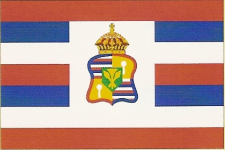
Hawaiian Royal Standard
|
Hawaiian Royal Standard 1810-1895
There were eight royal monarchs of Hawaii, from the formation of the Kingdom in 1810, until the overthrow of the Monarchy in 1893. This was one of their royal standards.
This Hawaiian Royal Standard shows the Hawaiian Coat-of-Arms, designed by Timothy Haalilio, the private secretary to King Kamehameha III. The heraldic description of the Coat Arms is: "Quarterly, 1 stand 4th the stripes of the national banner, 2nd and 3r dor, a Puloulou– a ball argent on a staff sable – in escutcheon vert, a Puela – a triangular banner argent – over an Alia – two spears argent in saltire. The supporters are the twin brothers Kameeiamoku and Kamanawa, statant, clad in the ancient feather cloak and helmet, the one on the dexter bearing a spear and the one on the sinister bearing a Kahili. Over all, a representation of the Hawaiian Crown. Mantle, a King’s feather cloak and the Kings new motto: "Ua mau ke ea o ka aina I ka pono."
In ancient times Puloulou were placed on either side of the door to the King’s house, or other building under royal authority, to indicate protection or a place of refuge, to which a person might flee from danger and be safe. The Puela was a banner which was raised to the masthead of a Kings or Noble´s vessel, a form of ancient Hawaiian vexilloloid; on land it was placed across the Alia in front of a dwelling to indicate royal protection. A Kahiliis tall staff topped with a cylinder of feathers which was, and still is, used as a mark of an individual’s noble or royal standing. |
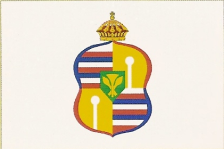
Hawaiian Royal Standard
|
Hawaiian Royal Standard (Variant) 1810-1895
It is interesting to note that Hawaii is the only U.S. state that was once a kingdom with its own monarchy. The only real royal palaces in the United States are in Hawaii.
The Iolani Palace was completed in 1882, during the reign of David Kalakaua, the last king of Hawaii. It had electricity years before the White House did. The last royal to live there was Kalakaua's sister, Queen Liliuokalani, who abdicated in 1895 after the overthrow of the monarchy.
The white variant is shown on the Hawaiian Kingdom Government website as the Royal Standard, and a flag of that type survives from King David Kalakaua’s coronation. There is some speculation, however, that this flag might be the personal standard of Princess Lydia Liliuokalani, heir presumptive to King Kalakaua. The other two personal standards shown below are those of Liliuokalani’s younger sister Princess Miriam Likelike and her daughter Princess Victoria Kaiulani, respectively, second and third in line to the throne. Thus, it seems logical that the Heir Presumptive would have had a personal standard since her younger sister and niece had their personal standards. |
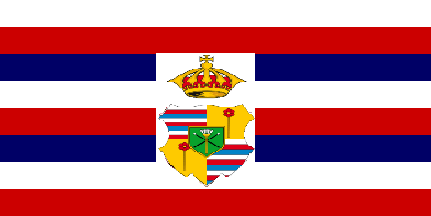
King Kalakauai´s
Royal
Standard
|
Standard of the King Kalakauai (doubtful)
King David Kalakaua, sometimes called the "Merrie Monarch," was the last reigning king of the Kingdom of Hawai'i. The Hawaiian legislature appointed him king in 1874 and he ruled until his death in San Francisco in 1891. Kalakaua was a scholar, musician, inventor, composer, and world traveler. He, and his wife Queen Kapiolani, traveled all over the world attempting to gather goodwill and support for Hawai'i, and while he was away, his sister, Queen Liliuokalani ruled as regent. The Iolani Palace was built during his reign in 1882. Kalakaua attempted to increase the power of the Hawaiian monarchy and its native people, which angered many foreign settlers living in Hawai'i. The foriegners, mostly Americans, eventually forced him to accept a new "Bayonet Constitution," which gave them power over Hawaii. His last sad words before his death were, "Tell my people I tried." He was succeeded by his sister Queen Liliuokalani.
This depicted personal standard for King Kalakauai and its historical usage in the Kingdom of Hawai'i is very questionable and not documented. |
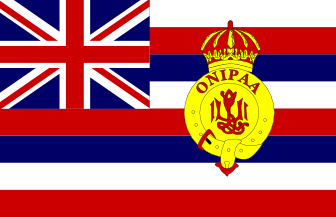
Queen Liliuokalani's
Royal Standard
|
Queen Liliuokalani's Royal
Standard 1838-1917
Queen Lili'uokalani was the last monarch of the Hawaiian Islands. She reigned from 1891 to 1893. Unfortunately for her, American businessmen and settlers overthrew her royal government and established a puppet constitutional monarchy supported by the American military. In 1898, Hawaii was completely annexed by the United States and she was forced to give up her throne. She would spend the rest of her life trying to regain her title, her people's rights, and protecting their traditions. This flag has been identified as Queen Liliuokalani's Royal Standard.
The flag was basically the Hawaiian Kingdom's flag with the addition of Queen Liliuokalani's emblem on the fly. The emblem has a crown above a yellow shield having her initial and the Hawaiian word of "ONIPAA" in red on it. Usually, the Hawaiian word "Onipa`a" is translated as "hold fast," or "steadfast," and comes from Queen Liliuokalani's motto "E Onipaa Kakou" (Let us all be steadfast). |

Queen Liliuokalani's
Personal Royal Standard
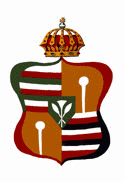
Detail of Personal Shield
|
Queen Liliuokalani's Personal Standard
This Hae Kalaunu (Royal Standard) of Her Majesty Queen Lili'uokalani was seized by Col. John Soper by order of the Provisional Government of Hawai'i after the Queen refused to lower her personal standard at her home. They did so claiming they were "protecting" the islands from Queen Lili'uokalani's revolutionary attempt to alter the Hawaiian constitution. Lili'uokalani proposed a constitution that would strip Hawaii's privileged "haoles" (foreign population) of their voting rights unless they agreed to became naturalized citizens of the kingdom and relinquished their citizenship to any other country. The Hawaiian Revolution of 1893 eventually resulted in the annexation of the Hawaiian Islands by the United States in 1898.
This long royal standard flew over her Washington Place home on the day the Hawaiian Kingdom was overthrown and eventually disappeared into the private collection of the Soper family. It was obtained through a private acquisition and donated to the Public Archives. Plans are to permanently display it to the public at Queen Lili'uokalani's home. The same basic design was also used for her younger sister Princess Miriam Likelike and granddaughter Princess Kaiulani, the last heir of the royal Kalakaua line. |
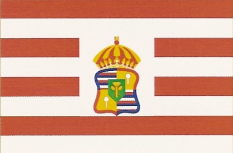
Princess Likelike Flag
|
Princess Likelike Flag 1851-1887
Princess Miriam Likelike (1851–1887) was the younger sister of Princess (later Queen) Lydia Liliuokalani, and thus second in line for the throne of King David Kalakaua. In 1870, she married Archibald Scott Cleghorn, a businessman from Scotland almost twice her age. Five years later she gave birth to a daughter, Princess Kaiulani, who would be the only Kalakaua of her generation. From that time on Kaiulani became the focus her life and the future of the kingdom she might one day inherit. The marriage didn't last, however, and in the end the princess simply returned to Big Island of Hawaii and refused to go back to her husband. She later served as Governor of the island in 1879-1880.
Princess Likelike was well-liked by all, and her home was opened to important people from all over the world. She had a reputation of being a kindly, gracious hostess in almost every country of Europe and almost every state of the union. She would always be up with the latest fashions, ordering dresses and clothing from Paris. The cause of the princess's death is still unknown; she is said to have simply taken to her bed and refused all food. On February 2, 1887, Princess Likelike died at age 36, before her daughter reached her teenage years. |

Princess Kaiulani Flag
|
Princess Kaiulani Flag 1875-1899
Crown Princess Victoria Kaiulani (1875-1899) was the daughter of Princess Miriam Likelike, and the last heir to the Hawaiian throne. She became known throughout the world for her intelligence, beauty and determination. After the overthrow of the Hawaiian monarchy in 1893, she spearheaded a campaign to restore the Kingdom. In New York, she made many speeches and public appearances denouncing the overthrow of her government. In Washington, D.C., she spoke before the United States Congress and pleaded with U.S. President Benjamin Harrison and later Grover Cleveland, but her negotiations could not prevent eventual annexation.
In 1898, while on a horse ride in the mountains of Hawaii, she got caught in a storm and came down with a fever. She never completely recovered and died in 1899 at the age of 23. Her life story grew to legendary proportions after her death. Some Hawaiians believe that Kaiulani died of a broken heart, having suffered many losses in her life. Her father said that he thought that since Hawaii was gone, it was fitting for Kaiulani to go as well. She is buried in Honolulu's Royal Mausoleum of Hawaii.
After her death, her aunt, the deposed Queen Liliuokalani, recognized another relative, David Kawananakoa as the heir of Hawaiian Royal House, and adopted him. |
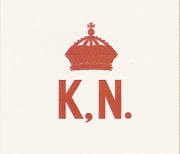
Kuhina Nui Flag
|
The Kuhina Nui Flag 1816-1864
The Kuhina Nui, which translates directly as "Great Minister," but was generally translated as "Premier" in the first half of the 19th century, was an official, generally the Queen or some other member of the Royal Family, could exercise all the executive powers of the King if necessary.
The office was abolished in 1864, and hence the use of the standard. After 1864, the Hawaiian Premier or Prime Minister was a Cabinet member in the usual sense who didn’t have a flag.
The Kuhina Nui flag is described in the French naval book as being the banner of Princess Victoria Kamamalu, which is true to a point. She held the office of Kuhina Nuifrom 1855 to 1864 in the reigns of both King Kamehameha IV and King Kamehameha V, but as the position was appointive and one served, as the lawyers say, "at pleasure," the appointment could have been revoked at any time and given to someone else. In that case, the flag would have gone to the new appointee. |
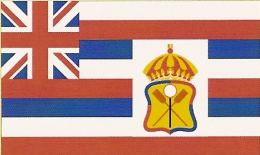
Hawaiian Naval Ensign
|
Hawaiian Naval Ensign 1887-1898
The Hawaiian navy developed from the village warriors of Kona under Kamehameha I, who unified Hawaii in 1810. The navy used both traditional canoes and uniforms like the gourd helmets and loincloths, as well as western technology like artillery cannons, muskets, and small European ships. When Kamehameha died in 1819 he left his son Liholiho a large "navy" with thousands of warcanoes and a few larger warships.
King Kalakaua (1874-1891) was interested in modernising the Hawaiian military. As part of this program a training vessel, H.M.S. Kaimiloa, was acquired and in 1887 the King requested Isobel Strong to design a naval ensign. The charges on the shield, a Puloulou and two crossed red Kahilis, represent the King and his heirs. There is photographic evidence of H.M.S. Kaimiloa flying a jack bearing the eight stripes of the national banner, but the photograph does not show the commission pennant, so that may or may not have still been in use in 1887.
By 1887, both the army and navy, had shrunk in size to eventually become that of a royal bodyguard and police force. |
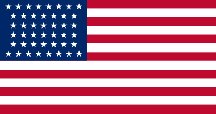
44-Star United States Flag
|
United States of America Flag 1891
Hawaii lost its independence to an armed revolt led by American residents in 1893, and was annexed to the United States in 1898.
American business interests supported the overthrow of the Hawaiian government in January of 1893, whereupon they hoisted the Stars and Stripes. At first rebuffed in their attempt to secure annexation by the United States, the new leaders proclaimed Hawaii a republic in 1894 under its former national flag, but in 1898, it was officially made a U.S. territory. The former national flag of the kingdom and the republic was adopted, unchanged, by both the territory, and later, the state. |
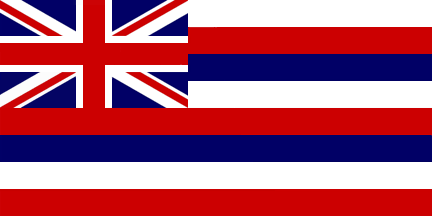
State of Hawaii Flag
|
The Territory of Hawaii 1898-1960
The State of Hawaii Flag 1960
On August 12, 1898, Hawaii became a U.S. territory, and 61 years later it was admitted to the Union as the 50th state. In 1960, a star was added to the flag of the United States representing Hawaii, and bringing the total number of stars on the U.S. flag to 50.
This is now the official flag of the State of Hawaii. It is authorized to represent the State of Hawaii on land and sea, and authorized for executive state agencies, second only to the stars and stripes of the United States. |
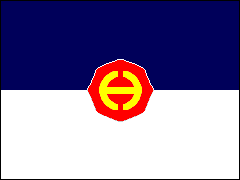
Hawaiian Department Flag
|
US Army Hawaiian Department Flag
Prior to World War II, US Army commands in major overseas territories of the US were called departments. A department was roughly equivalent to a corps; but besides its basic defense mission with assigned combat units, it had general responsibility for command and control of all Army units in the territory. The Hawaiian Department was introduced in 1922. In 1944, the Hawaiian Department was renamed the Central Pacific Base Command, but the flag remained unchanged.
The Hawaiian Department used scarlet and yellow, since they are the old Hawaiian royal colors, the octagon shape symbolizes the eight islands of the group, and the name of the territory is indicated by a stylized "H" in yellow. The same symbol is still in use but US troops as a shoulder sleeve insignia for the US Army Garrison in Hawaii. |
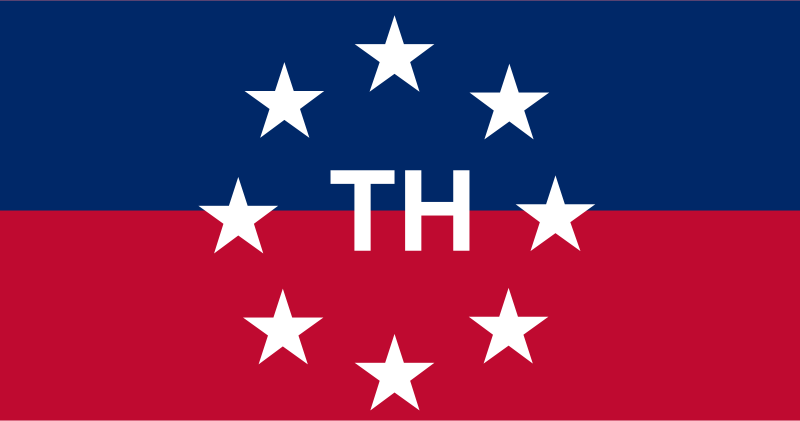
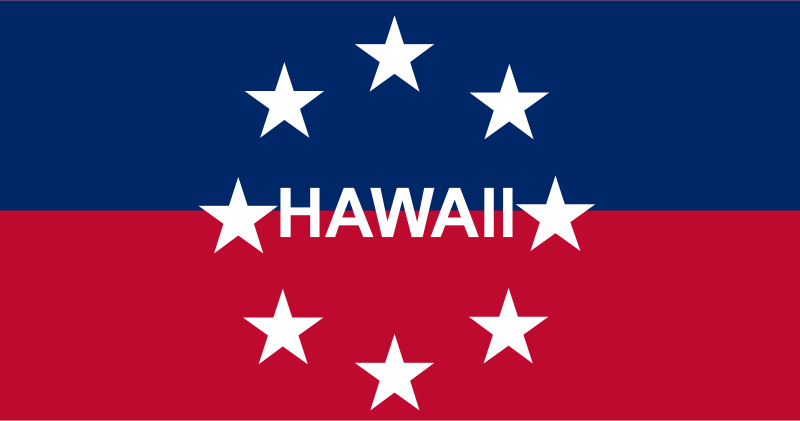
Hawaiian Governor´s Flags
|
The Governor of the State of Hawaii Flags 1898
The flag used by the Governor of Hawaii is a red and blue bicolor with a circle of eight white stars. The eight stars stand for the eight major islands in the Hawaii chain. They are Hawaii, Oahu, Kauai, Kahoolawe, Lanai, Maui, Molokai and Niihau.
Between 1898 and 1959, the time Hawaii was a United States territory, in the middle of the eight white stars were the letters "TH," which stood for the "Territory of Hawaii." This flag was reportedly designed by an adjutant general of the Territorial Governor.
In 1960, Hawaii officially became the 49th State of the Union, and those letters "TH" where replaced with the name of the state in all capital letters "HAWAII."
In 1990, the then Governor of Hawaii, John D. Waihee III, proclaimed July 31 to be "Ka Hae Hawaii" (Hawaiian Flag Day). It has been celebrated each year since then honoring all the flags of Hawaii. |
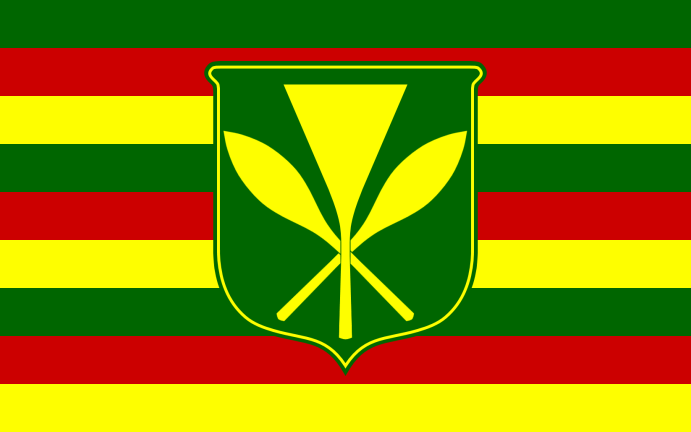
The Kanaka Maoli
|
Native Hawaiian Flag 2001
The Kanaka Maoli (native Hawaiian) flag is said to have been Kamehameha’s personal flag long before the modern Hawaiian flag. According to its creators, British Navy Captain Lord George Paulet destroyed the Kanaka Maoli when he took control of Hawaii for five months in 1843. However, the flag that Paulet confiscated was the red, white and blue striped Hawaiian flag devised around 1816 for Kamehameha I and of which the modern US State flag is directly descended. The Kanaka Maoli flag is a modern commercial invention hoping to appeal to those supporting a Hawaiian sovereignty movement. The Kanaka Maoli Flag was created in 2001 by Gene Simeona and then produced by his business partner Stan Fonseca. There is no historical evidence of the flag´s existance before this time.
At the flag´s center is a green shield bearing a coat of arms, which includes a kahili, the original Hawaiian royal standard, and two paddles, meant to represent the voyaging tradition of the Native Hawaiians. The flag´s color scheme is red, yellow and green, meant to represent different groups within Hawaiian society. The yellow is symbolic of the "alii," the powerful royal class. Red represents the "konohiki," the landed caste that served the alii. Green signifies the "makaainana," or commoners.
The flag has become popular in recent years and can be found on everything from t-shirts to bumper stickers. |
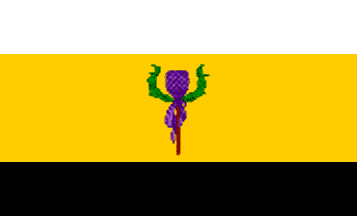
Nation of Hawai'i Flag
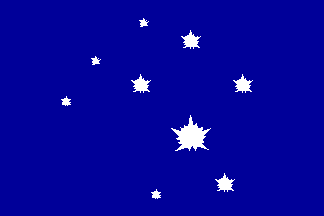
Ka Lahui Hawai Flag
|
Hawaiian Independence Flags
Since Hawaii became part of the United States there have been several local groups or movements whose goals were independence for Hawaii. The Nation of Hawai'i is a pro-independence group of people who claim descent from the original inhabitants of the islands. They use a white-yellow-black horizontal tricolored flag with a "Kahili" symbol in the middle yellow band. The Ka Lahui Hawai, also known as the Polynesian Sovereignty Movement, are another group desiring independence who use a flag with a white constellation of stars placed on a dark blue field.
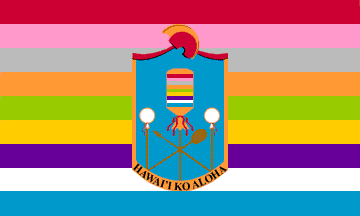 Hawai'i Ko Aloha Hawai'i Ko Aloha Flag 2004 A third group, known as Hawai'i Ko Aloha claim to represent all the lineal descendants of Hawaiians from Maka'ainana to Alii. The colors of the background of their Flag represent the Nine islands of the inhabited Hawaiian chain prior to the arrival of the western exploiters. The saying Hawaii ko Aloha means "Love of our land of Hawaii." |
| Flags of Hawaii |Flags of Spain | Flags of Cuba | Flags of the Philippines | Flags of Puerto Rico | Flags of United States |
Period Flags of Spanish Empire
The Spanish–American War was an armed military conflict between Spain and the United States between April and August of 1898 to free the Island of Cuba from Spain. However, strong expansionist sentiments in the United States made it clear that the war was an excuse to annex the remaining Spanish overseas territories of the Philippines, Puerto Rico, and Guam. The result was that war ushered in a period of regional distrust against the United States. Before the war the United States had been seen by the Central and South American nations in their struggle for independence from Spain Empire as protective sister nation, but it became apparent to these nations that the United States had not gone to war against Spain to give independence to Cuba and establish a representative government, but that they now believed in their own superiority and now looked on the emerging Latin American democracies as inferior. This distrust would derail efforts towards pan-American cooperation for years.
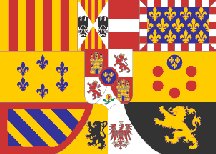
Royal Standard
|
Spanish Royal Standard 1761-1931
This royal standard was used by Kings Charles III and IV, Ferdinand VII, Elizabeth II and Alphonse XII and XIII. Since there wasn't yet a single Spanish national flag, this standard was commonly used by the Royal Spanish Government in lieu of a national flag.
This confusing royal standard was divided into three rows of coat-of-arms including: top row - Aragon, Aragon-Sicily, Austria, Burgundy; middle row - Farnese (Parma), in center escutcheon (Castile, Leon, Granada, Anjou), Medici; bottom row - Bourgogne, Flanders Tyrol.
|
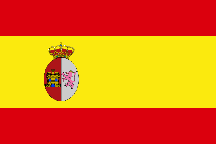
National Combat Flag
|
National War Ensign 1785-1931 and National State Flag 1843-1931
In 1785, King Charles III replaced the existing war ensign (a white field with the Spanish coat-of-arms centered on it), with a new, distinct ensign which could not easily be mistaken with those of other countries.
In 1843, the design also became the official Spanish State Flag. This basic background design is still used today in the modern Spanish national flag with the Royal Shield being replaced by a more modern coat-of-arms.
|
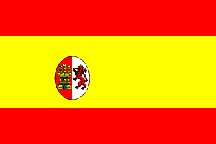
Republic Flag 1873
|
First Spanish Republic Flag 1873-1874
The short-lived First Spanish Republic. It lasted twenty-three months, between February 11, 1873, and December 29, 1874, and had five presidents. It then collapsed, leading to the restoration of the Bourbon monarchy with the proclamation of Alfonso XII as king.
Unlike the Second Republic (1931-1939), the First Republic's flag was almost identical to the Royal flag of 1785, only with the crown removed. Actually the law said a piece of material should be stitched over the crown of the existing flag resulting in the coat-of-arms not being centred vertically, but slightly offset to the bottom of the middle stripe. In 1874, the Royal Ensigns returned, usually with the quick removal of the additional stitched piece of material. |
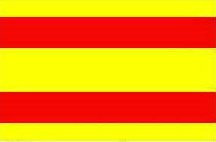
Civil Flag
|
Spanish Civil and Merchant Flag 1785-1927
Shortly after the collapse of the First Republic, a new flag was designed to be used by civilians, non-governmental organizations, and by private Spanish merchant ships as the national ensign in lieu of the more-official Royal Flag. |
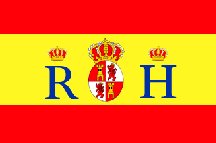
Spanish Customs Ensign
|
Spanish Royal Customs Flag 1791-1867
The first Spanish customs, or treasury ensign, showing the crowned letters R and H, was adopted by a Royal Decree in August of 1791. This flag was used at Spanish customs houses and treasury buildings. |
| Flags of Spain | Flags of Cuba | Flags of the Philippines | Flags of Puerto Rico | Flags of Hawaii | Flags of United States |
Period Flags of Cuba
In 1895, an armed uprising against Spanish authority in Cuba began. The Spanish Captain General of Cuba, General Valeriano Weyler, pledged to suppress the insurgency by isolating the rebels and cutting off their supplies. By the end of 1897, more than 300,000 Cubans had been relocated into concentration camps where hunger and disease killed more than one hundred thousand captives. A propaganda war waged in the United States by Cuban émigrés won the sympathy of the American population, and Weyler was referred to as "The Butcher" by yellow journalists like William Randolph Hearst, who began agitating for intervention with stories of Spanish atrocities against the Cuban population. The result was the Spanish-American War and the invasion of Cuba. Although U.S. Troops withdrew from Cuba after the war, the treaty also established a perpetual lease of Guantanamo Bay for a United States Naval base.
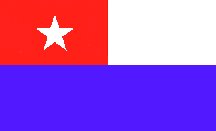
Cespedes Flag
|
Cespedes Flag 1868
This was the flag was used by Carlos Manuel de Céspedes, known as the Father of Cuba, in his famous uprising known as the "Grito de Yara" in 1868. In October 1868, he proclaimed the independence of Cuba from Spain and captured the town of Bayamo. That marked the beginning of the terrible "Ten Years' War." Although confined to the eastern region of the island, the war forced Spain to send over one hundred thousand troops to put it down. Céspedes was eventually killed by the Spaniards in an ambush in 1874 and the 10 Year War ended in 1878 with a truce that allowed the Spanish rule over Cuba to continue.
In honor of Cespedes and the bravery of the residents of Bayamo, who burned their prosperous city to the ground and moved to the forest rather than surrender it to the Spaniards, Bayamo was proclaimed a national monument. Ever since Cuba gained independence from Spain, the flag of Bayamo is often displayed alongside the Cuban national flag at official ceremonies and events. It is also used as the Naval Jack of Cuba.
|
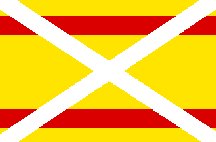
Autonomists Flag
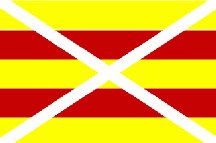
Variant Autonomists Flag
|
Cuban Autonomists Flags 1895-1899
Autonomism refers to a set of left-wing political and social theories similar to those of the socialist movement that favored the creole planter elites of Cuba. The first political party to follow these principalities was established in July of 1878, and called the new Liberal Party (or Autonomist) and proclaimed a commitment to actualizing the promises of the reformer Zanjón. The strength of the new party came from the rich planters and their allies, who were anxious to steer a course between the uninspired colonial policies of the Spanish government and the uncertainties associated with the radicals wanting complete separation from Spain.
In late 1878, a second Autonomist political party called itself the "Partido Unión Constitucional" was formed. This party was very pro-Spanish, and attracted to its ranks the most of the Cuba española" (Spanish Cuba) population who rejected the insurgent separatists policy of revolution and independence for Cuba. After the Ten Years' War, the founders of the party, former annexationists and reformists, called for a system of local self-government patterned on the English colonial model and requested numerous economic and political reforms, but still within the Spanish empire.
The autonomic flag was hoisted in 1895 in Baire as the symbols of the Cuban Nation. The design was popular because this historical Cuban flag could be made using a Spanish Merchant Flag and simply adding two diagonal stripes.
|
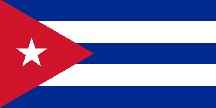
Cuba Flag
|
Republic of Cuba Flag 1902
When Cuba became independent from Spain in 1902, the Cespedes Flag was officially designated to be the flag of the City of Bayamo where Céspedes was born, and this flag which Narciso López flew in the City of Cárdenas in 1850, was officially designated as the new Cuban national flag.
The meaning of the shapes and colors of the Cuban flag are that the blue stripes refer to the three old divisions of the island, the two white stripes stand for the strength of the independentist ideal, the red triangle stands for equality, fraternity and freedom as well as for the blood split in the struggle for independence, and the lone star symbolizes the freedom of the people.
|
| Flags of Hawaii |Flags of Spain | Flags of Cuba | Flags of the Philippines | Flags of Puerto Rico | Flags of United States |
Period Flags of the Philippines
The first battle between American and Spanish forces in the Philippines took place at Manila Bay on May 1, 1898. In a matter of hours, a United States Navy Squadron under Commodore George Dewey, defeated the Spanish squadron under Admiral Patricio Montojo y Pasarón, with only nine American sailors wounded. Commodore Dewey had transported Emilio Aguinaldo to the Philippines from exile in Hong Kong in order to rally Filipinos against the Spanish colonial government and, on June 12, 1898, Aguinaldo declared the independence of the Philippines.
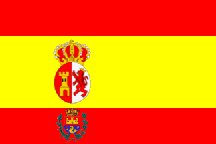
Royal Philippine Flag
|
Royal Philippine Company Flag 1793-1898
The ensign of the Royal Philippines Company was basically the 1785 war ensign bearing the arms of Manila city, with an oval escutcheon, royally crowned, on the red stripe beneath the national arms on the ensign.
Even though the Royal Philippines Company Flag was shown in the first (1819) edition of the "Album des Pavillons," its real existence remains dubious. |

Katipunan Flag (type #1)
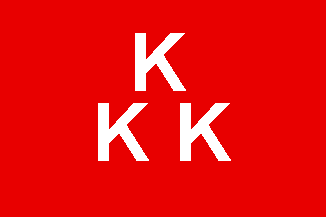
Katipunan Flag (type #2)

Katipunan Flag (type #3)
|
Katipunan Flags 1892-1897
These flags were used by the Katipunan (The Society) in the Spanish Philippines. The Spanish ruled the Philippines for over 400 years, but in the late 1900s nationalist groups were formed to drive out the Spaniards. Andres Bonifacio, popularly regarded as the "Father of the Philippine Revolution," founded the Katipunan movement, which was the main nationalist group which fought against the Spanish for Filipino independence. The K's stood for Kataastaasan Kagalanggalangan Na Katipunan ng Mga Anak Ng Bayan (Highest and Most Respectable Society of the Sons of the People).
The Katipunan flag (type #1) was a red rectangle red with three "K" white in a horizontal alignment. Some members of the movement used a variant of the flag (type #2) on which one of the three "K"s was put above the other two forming a triangle. A third variant (type #3) had a single K on it.
|
|
|
Katipunan flag of 1897 |
|
Llanera's Skull |
In 1897, a red flag with the "Sun of Liberty" of the Naic Assembly saw limited use as the flag of the Republic of Biak-na Bato. Some consider this Katipunan flag to be the first official flag of the Philippines.
A black flag, known as Bungo ni Llanera (Llanera's Skull), with one white K and a skull and crossbones was used by General Mariano Llanera in the provinces of Bulacan, Tarlac, Pampanga, and Nueva Ecija. None of the actual Katipunan rebellion flags survived and all images shown here are based on written descriptions. |
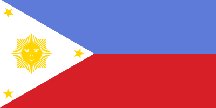
First Republic Flag
|
First Philippine Republic Flag 1898
This Filipino flag was sewn by the revolutionary junta in Hong Kong and first displayed in battle in 1898. It was formally unfurled during the proclamation of Philippine independence on June 12, 1898, by President Emilio Aguinaldo. The design was a mythical sun (with a face) common to many former Spanish colonies; the triangle of Masonry; the eight rays represent the first 8 provinces that revolted and were put under martial law by the Spaniards during the start of the Philippine Revolution in 1896; the flag first had the blue stripe above, but was reversed with the red stripe above upon the commencement of hostilities between the Filipinos and Americans in 1899. |
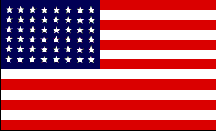
United States Flag
|
The 48-Star United States of America Flag 1912-1959
Following the land assualt on the city of Manila by the forces of Commodore George Dewey in 1898, Filipino forces were prevented from entering the captured city of Manila by their American allies, an action which was deeply resented by the Filipinos. This battle marked an end of Filipino-American collaboration. When the 11,000 U.S. troops began to take the place of the Spanish in control of the country, warfare broke out between American forces and the Filipinos resulting in the Philippine-American War.
This flag was the last United States flag to fly over the Philippine Islands before this former United States Territory became an independant nation after World War II (see below). |
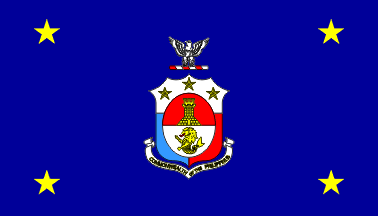
Governor-General Flag (speculative)
|
US Governor-General 1898-1935
An American military government was established following the defeat of Spain and the surrender of Manila on August 13, 1898, thus ending that phase of the Spanish-American War. During this period, executive authority in all civil affairs in the Philippines was exercised by a military governor. General Wesley Merritt was the first American Military governor of the Philippines. Prior to 1935, there was a governor-general's flag for the Philippines, but no image has been found.
Written descriptions suggest that the seal of the Philippine Islands was centered on a blue flag with yellow stars in each corner similar to this speculative drawing. |
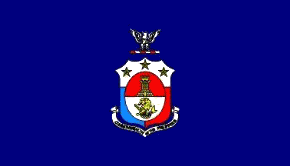
Commonwealth Flag
1935-1939
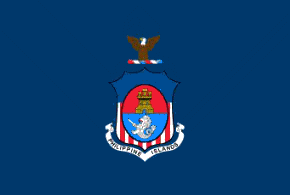
Commonwealth Flag
1939-1945
|
Presidental and Philippino Commonwealth Flags 1935-1946
With the inauguration of the autonomous Commonwealth of the Philippines in 1935, a flag was adopted for the President of the Philippines, as well as for the US High Commissioner. The High Commissioner was the successor to the US Governors-General, and representated American intrest in the islands. The presidential flag between 1947 and 1951 was similar, but with a new presidential seal replacing the seal of the commonwealth.
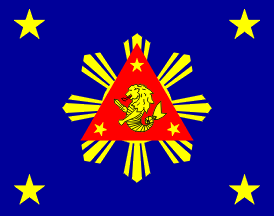 New Presidential Flag 1946 The Philippine presidential flag of 1946 was based on the American presidential flag of the time: a navy blue flag defaced with the new presidential seal in the center, and one yellow five-pointed star in each corner. It was customary to use a gold fringe on this flag indoors. |
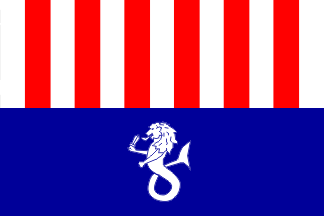
High Commissioner's Flag
|
US High Commissioner Flag 1935-1946
This was flag of the American High Commissioner of the Philippine Islands. He was the representative of the President of the United States to the Philippines during the Commonwealth period preparatory to their final independence. The High Commissioners replaced the Governors-General
The Commissioners were: Frank Murphy (later Justice of the US Supreme Court), Paul V. McNutt (later the first US ambassador to the Philippines), and Francis B. Sayre, the son-in-law of Woodrow Wilson. |
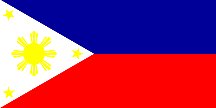
Philippines Peace Flag
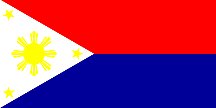
Philippines War Flag
|
Second Republic of Philippines Flag 1946-present
The Philippine–American War (1899-1913) was an armed military conflict between the United States and the Philippines, which arose from the First Philippine Republic's struggle against the United States annexation of the islands. This conflict is also known as the "Philippine Insurrection" because the American government never recognized the declaration of war by Emilio Aguinaldo. The war officially ended in 1902, however, remnants of the Philippine Army and other resistance groups continued hostilities against American rule until arround 1913.
The American promise of independence was finally granted in 1946 and this flag became the Filipino's national flag. The sun is said to represent the dawning of a new era of self determination, the eight rays stand for the eight provinces that rose in revolt against Spanish rule. The three stars stand for the three principal geographic areas of the country, Luzon, the Visayas and Mindanao. The red stripe represents courage and bravery of the people and the blue stripe is for their noble ideals. The white triangle stands for the Katipunan, the revolutionary organization that led the revolt against Spain and the color white represents peace and purity. In peacetime, the blue stripe is uppermost, but during wartime, the red stripe is flown on top. |
| Flags of Hawaii |Flags of Spain | Flags of Cuba | Flags of the Philippines | Flags of Puerto Rico | Flags of United States |
Period Flags of Puerto Rico
The process of Puerto Rico becoming a United States Territory began in 1898, when Lt. Henry H. Whitney was sent to Puerto Rico on a reconnaissance mission. He provided maps and information on the Spanish military forces to the U.S. government prior to the Spanish-American War invasion. In 1899, forces of the United States Navy under the command of Rear Admiral William T. Sampson and the United States Army under General Nelson A. Miles attacked San Juan. The first land skirmish between the American and Spanish troops occurred in Guanica, followed by battles at Yauco, Fajardo, Guayama, Guamani River Bridge, Coamo, Silva Heights and finally by the Battle of Asomante. All military action in Puerto Rico was suspended after the signing of the Treaty of Paris was made public, in which Puerto Rico became a United States Territory, which it still remains.
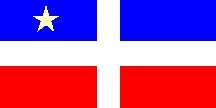
Lares Flag
|
Grito de Lares Flag 1868
This is the Grito de Lares flag. Lares is a small inland mountain town where a premature and unsuccessful rebellion was staged against Spain in 1868. Even though written material from the time speaks of the star as being white, the star is actually pale yellow. The flag is still preserved at the University of Puerto Rico.
The Lares flag was originally intended to become the national flag of a new republic and was designed by Ramon Betances and embroidered by Mariana Bracetti for that purpose. |
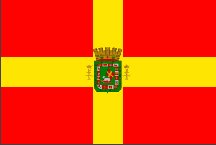
Puerto Rico Flag
|
Republic of Puerto Rico Flag 1873-1875
During a very short period of time, from 1873 to 1875, a Republic was proclaimed in Spain, after the dethronement of Isabella II (1833-1868) and the following abdication of Amadeus, Duke of Aosta, as King (1870-1873). The change from Kingdom to Republic was apparently felt, at least vexillologically, in Puerto Rico with the incorporation of a new Coat of Arms and flag. Both images can be seen in the small museum at Arecibo's Museo del Faro (Lighthouse Museum). Nobody is sure how long they were used, if ever.
In 2014, a movement was organized in San Juan for the "reunification" of Puerto Rico with Spain, in direct conflict with those Puerto Ricans who campaign for Puerto Rican territory full statehood in the United States. They are using a flag that seems to be based on this flag.
|
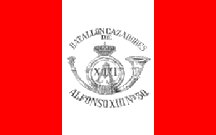
30th Chasseurs Battalion
|
30th Chasseurs Battalion of Alfonso VIII Flag 1898
This Spanish flag captured by American troops on the earthworks at Aibonito on the last night of hostilities in Puerto Rico. On August 9, 1898, United States infantry and cavalry troops encountered Spanish and Puerto Rican soldiers armed with cannons in a mountain pass known as Cerro Gervasio del Asomante, while attempting to enter Aibonito. The American commanders decided to retreat and regroup, returning on August 12, 1898, with an artillery unit. The Spanish and Puerto Rican units began the offensive with cannon fire, being led by Ricardo Hernáiz. The sudden attack caused confusion among some of the American soldiers, who reported seeing a second Spanish unit nearby. In the crossfire, four American troopers were gravely injured. Based on this stiff resitance and the reports of upcoming reinforcements, United States Commander Landcaster ordered a temporary retreat. All military action in Puerto Rico was suspended later that night, after the signing of the Treaty of Paris was made public
|
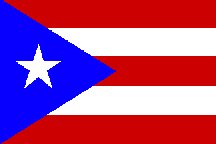
Puerto Rico Flag
|
Puerto Rico Flag 1895
The flag was created in 1895, by the Puerto Rican section of the Cuban Revolutionary Party, which advocated independence for Puerto Rico and Cuba from Spanish rule. Its design is the same as the Cuban flag, but with the colors inverted. It has five horizontal stripes, alternating red and white, with a white star on a blue triangle in the extreme left. Puerto Rico became a United States territoty after the Spanish-American War in 1899 and has remained so up until the present.
Before 1952, the police arrested anyone displaying the flag on charges of insubordination against the United States. Today, the flag is the island's official flag. |
| Flags of Hawaii |Flags of Spain | Flags of Cuba | Flags of the Philippines | Flags of Puerto Rico | Flags of United States |
Period Flags of the United States
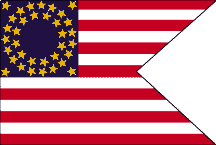
Union Cavalry Guidon
|
The 7th U.S. Cavalry Guidon 1876
This was one of the two flags that Colonel George A. Custer and the Seventh Cavalry carried at the Battle of Little Big Horn in 1876. The Battle, also known as Custer's Last Stand, and the Battle of Greasy Grass Creek by the Native Americans, was fought between Lakota and Northern Cheyenne forces and the 7th Cavalry Regiment of the United States Army. It occurred on June 25-26, 1876, near the Little Bighorn River in the eastern Montana Territory. The battle was the most famous action of the Great Sioux War of 1876-77.
The U.S. Cavalry used guidons similar to this one in all the Plains Indian Wars. In fact, the cavalry was the last of the three branches of service of the U.S. Army to carry the Stars and Stripes into battle.
|
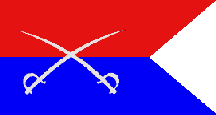
Custer's Personal Guidon
|
Custer's Headquarters Guidon 1876
This flag was the personal headquarters flag for General George Custer. It was made by his wife Libby. The original was lost at the battle of the Little Bighorn. It is believed that this flag was made of silk, but no authentic documentation has been found to prove its dimensions. The flag was carried by a Sergeant Robert Hughes, who rode directly behind the General. It was swallow-tailed of equal horizontal stripes of red over blue with two crossed white sabers in the center. Both the Guidon and the personal flag were carried into the battle.
|

Buffalo Soldier's Guidon
|
U.S. 9th Cavalry Regiment, Company I Guidon
This is the guidon that was carried by the U.S. 9th Cavalry Regiment, Company I. After the Civil War, the 9th and 10th Cavalry regiments were made up of black soldiers and white officers. They were nicknamed the "Buffalo Soldiers" by the Indians because of their fierce fighting qualities and the texture of their skin and hair.
U.S. Army cavalry regiments all had red-over-white guidons with the regimental number over the troop letter. Although Custer's 7th Cavalry had a similar regimental flag, there is no documentation remaining to indicate that it was carried at the Battle of the Little Big Horn. |
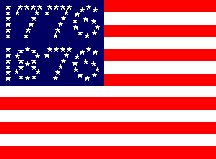
Centennial Flag
|
United States Centennial Flag 1876
A flag of thirteen stripes, red and white, and a blue canton with stars forming the dates 1776 and 1876 was made for the first United States centennial. Each of the stars on this flag has five broad points and five narrow rays set between them.
The flag, while unofficial, was quite popular and still sold today. Historical American flags such as this one are replicated in large numbers for decorative use. |
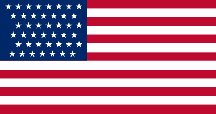
43-Star Flag
|
The United States of America Flag 1890-1891
In 1890, five stars were added, representing Idaho, Montana, North Dakota, South Dakota and Washington, bringing the total number of stars to 43. There were thirteen stripes representing the thirteen original colonies.
In the short period of time this flag was official, the Sherman Antitrust Act was passed, Yosemite National Park was created, the National American Woman Suffrage Association was founded, and the Wounded Knee Massacre took place.
|
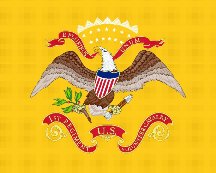
Rough Riders Flag
|
First United States Volunteer Cavalry Flag 1898
When the Spanish American War started, Teddy Roosevelt would resign his job as Assistant Secretary of the Navy to form the First U.S. Volunteer Cavalry. This unit mixed together seasoned Dakota cowboys, Ivy Leaguers from New England, New York City cops, and Pawnee scouts. He had more applicants than he could accept.
Newspapers nicknamed them "The Rough Riders" and they became the stuff of legends and helped propelled their commander into the White House. |

44-Star Flag
|
The United States of America Flag 1891-1896
In 1891, one star was added, representing Wyoming, bringing the total number of stars to 44. There were thirteen stripes representing the thirteen original colonies.
In the five years that this flag was official the Sierra Club was founded, Grover Cleveland was inaugurated President for second term, Plessy v. Ferguson affirmed the idea of "separate but equal," and gold was discovered in the Yukon's Klondike.
|
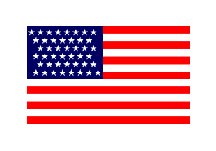
Peace Flag
|
The United States Peace Flag 1891
The Peace Flag of 1891, as depicted on the postage stamp, consists of 13 red and white stripes, a blue canton with 44 5-pointed stars, the whole design surrounded by a thick white border. Using their First Amendment rights, Americans have enthusiastically pursued religious, social, and political goals and modified the flag to show commitment to country and cause.
This flag was displayed in the 1890s by those who professed a dedication to world peace. Thier beliefs were symbolized by this flag.
|
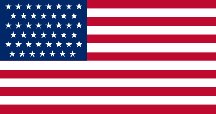
45-Star Flag
|
The United States of America Flag 1896-1908
In 1896, one star was added, representing Utah, bringing the total number of stars to 45. There were thirteen stripes representing the thirteen original colonies.
During the 12 years that this flag existed, Hawaii was annexed, William McKinley become President, the USS Maine exploded in Havana Harbor and the Spanish-American War was fought between Spain and the United States. During this time the first Boston subway was completed, American Samoa was occupied, the U.S. population exceeded 75 million for the first time, the first Rose Bowl game was played , William McKinley was assasinated, the Ford Motor Company made the first Model-T, the first World Series game was played, the first powered flight was made at Kitty Hawk, the Panama Canal Zone was acquired, the 1906 San Francisco Earthquake caused massive damage in Northern California, and the Federal Bureau of Investigation was established.
|
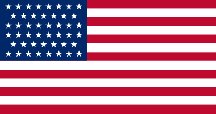
46-Star Flag
|
The United States of America Flag 1908-1912
In 1908, one star was added, representing Oklahoma, bringing the total number of stars to 46. There were thirteen stripes representing the thirteen original colonies.
During the years that this flag flew, Robert Peary planted the American flag at North Pole, the Boy Scouts of America were started, the first Indianapolis 500 was held, the RMS Titanic sunk, and Theodore Roosevelt was wounded while campaigning for the Bull Moose Party.
|
| Flags of Hawaii |Flags of Spain | Flags of Cuba | Flags of the Philippines | Flags of Puerto Rico | Flags of United States |
|